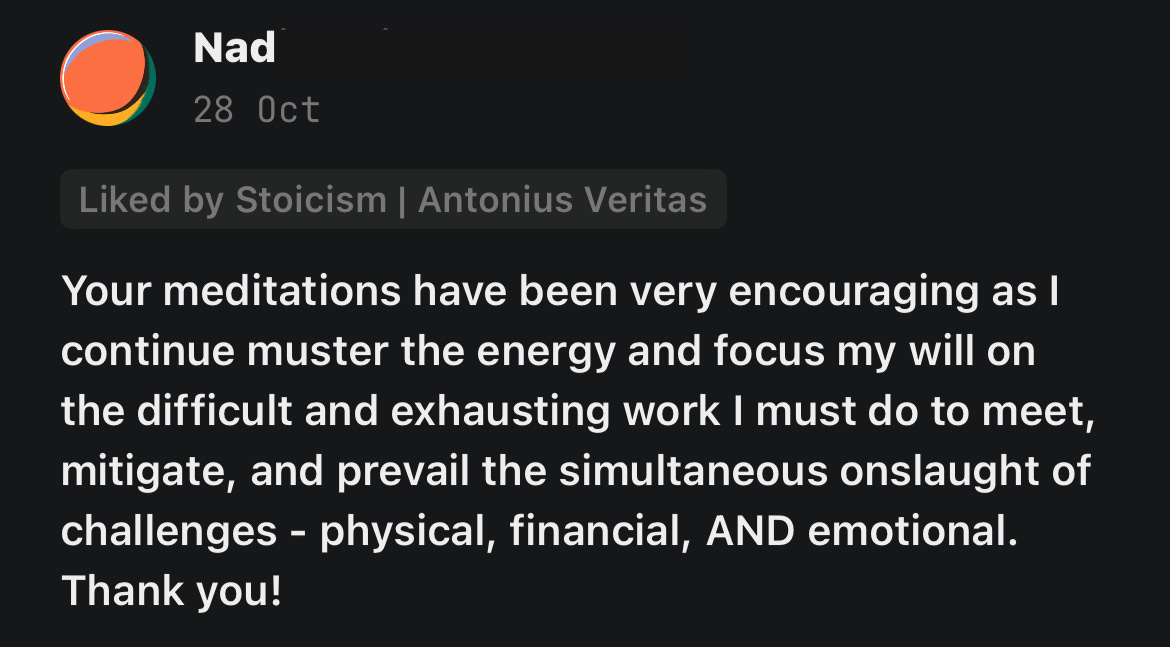Lead to Win I: Detachment
The art of detachment lies in this balance: staying close enough to grasp the gravity of a situation while stepping far enough away to see its solution.
The ‘Lead to Win’ section is a companion for The Stoic Manual to help you become wealthier, happier & more powerful through the best strategies and tactics to succeed at leading in your workplace, family, and business—by Dr. Antonius Veritas. Complement this with the ‘Neuroscience-based Tools’ section.
P.S: Scroll to the end for a mini-course, a step-by-step guide, on how to detach. This information is worth the $2,000 people spend on Leadership seminars.
Introduction
Many of you have requested me to tackle how best to lead through Stoic principles.
Today I’ve launched the Lead to Win section in that regard.
We’ll use some scenarios and stories from the hospital setting for illustrative purposes.
But ou don’t have to know what every jargon means to get value from the entries.
I want to reassure you that once you get the concept, from a first principles perspective, you’ll be able to apply it in any field.
“If you know the way broadly, you will see it in everything,” —Miyamoto Musashi.
In the following weeks, we’ll build up your foundation as a leader because you’re only as strong as it is sturdy.
Then we’ll move forward to other themes.
I recommend you read these entries in series, from the first one, while applying the practical guide of the mini-course I’ll be providing at the end.
Feel free to reach out in case of any questions, suggestions, or input.
Foundation 1: Detachment
“You have power over your mind – not outside events. Realize this, and you will find strength.“ —Marcus Aurelius
Leadership in the medical field transcends hierarchy.
It’s an art of responsibility and clarity.
And leading well centers on the practice of detachment.
Not as a retreat into cold impartiality or treating patients and other clients as lesser, but as an active pursuit of perspective in the face of complexity.
It’s the ability to step back and see the bigger picture without being consumed by immediate pressures.
Detachment creates space for thoughtful decisions, sharpens our awareness, and enhances our capacity to lead effectively in even the most chaotic moments.
In the fast-paced and high-stakes world of patient care, detachment is an indispensable skill.
Picture the operating room, where every team member has a role to play, from the circulating nurse to the anesthesiologist.
The rhythm of urgency is relentless, the stakes unforgiving, and the consequences of error profound.
A junior resident or intern might fixate on executing each step flawlessly—hanging on every directive, adjusting equipment, administering medications, or obsessing over immediate details—only to lose sight of the larger and consequential events unfolding around them.
On the other hand, the consultant surgeon maintains a steady gaze on the broader play.
He sees beyond the minute technicalities, guiding the procedure, and maintaining a steady vigilance over the bigger picture.
Detachment is this shift in focus: a deliberate widening of scope to assess the interplay of every moving part.
It’s active engagement with the full picture, ensuring precision and synergy in both individual actions and overall outcomes.
This widened perspective is a product of disciplined focus and putting in the work—a hallmark of leadership.
Detachment, however, isn’t an automatic feature you’re born with.
It’s a cultivated skill that begins with awareness: the ability to notice when we’re overwhelmed.
When our focus has narrowed to the exclusion of all else.
We’ve all experienced it—the surge of adrenaline that quickens our breath, tightens our grip, and narrows our gaze.
These physiological cues are not failings to be worried about or suppress, but signals, reminding us to pause and pull back.
We allow our vision to expand by consciously stepping back—both physically and mentally—and absorbing the immediate task and the entire landscape of the situation.
Consider a code blue scenario: where a patient’s life hangs in the balance.
The environment can feel overwhelming.
Calls blow up, orders ricochet, team members move frantically, and decisions must be made in seconds.
It’s easy for any leader to become consumed by the granular—compressions, intubation, the flashing ECG.
But a leader who practices detachment steps back—not away, but mentally above the chaos—to see it all clearly.
They assess the entire situation:
Is the team communicating effectively and functioning as a unit?
Are protocols being followed?
Is critical information being overlooked?
This detached clarity ensures that each team member performs their role seamlessly, transforming urgency into coordinated action.
It becomes the calm axis around which chaos revolves and ensures that everyone, from the person handling the oxygen to the bedside nurse, can perform at their peak.
Detachment is equally indispensable in the quieter, more intimate moments of medicine.
When delivering the life-altering news of a difficult diagnosis, stepping back mentally allows us to balance empathy with clarity.
It allows us to remain fully present while considering their emotional needs and the long-term implications of their care.
We read the room, regulate our own emotions, and adjust our approach in real-time to meet the patient’s needs.
Yet, detachment is not without risk.
Too much distance can breed disengagement, eroding the very connections and outcomes it seeks to preserve.
The art of detachment lies in this balance: staying close enough to grasp the gravity of a situation while stepping far enough away to see its solution.
It’s a dynamic process requiring constant recalibration.
You’ll also be wise to know that a detached leader doesn’t retreat from responsibility but rises above immediate distractions or demands to focus on what matters most.
Practical Ways to Cultivate Detachment
The 9 strategies below will help you cultivate detachment in your daily life so that you can lead with clarity and confidence.
So that your team can win!
You’ll also get step-by-step guidance on how everything works and detailed scenario drills to practice.
Let’s dive in.
Do you like this entry so far? ⭐️
Support the publication to read the rest and access 100+ practical insights and Mini-courses to help you apply Stoicism for a happier, wealthier life—Lead to Win, Neuroscience-based tools for Health Optimization & Stoic Essays.
Join 10,000+ other readers.
What my supporters are saying…






